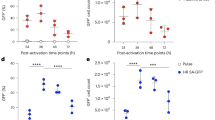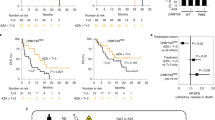Abstract
The transfer of drug resistance genes into hematopoietic cells is an experimental approach to protect patients from drug-induced myelosuppression. Because anti-cancer drugs are often administered in combination to increase their clinical efficacy, vectors that express two drug resistance genes are being developed to broaden the spectrum of chemoprotection. We have constructed a bicistronic vector, MFG/GST-IRES-CD (MFG/GIC) coexpressing rat glutathione S-transferase (GST) A3 isoform (rGST Yc1) and human cytidine deaminase (CD). Murine NIH 3T3 fibroblast cells transduced with this vector were evaluated for their resistance to nitrogen mustards and cytosine nucleoside analogs. GIC-transduced polyclonal cell populations (GIC cells) demonstrated marked increases in selenium-independent glutathione peroxidase (peroxidase) and CD activities, as well as increased resistance to melphalan (2.3-fold), chlorambucil (3.4-fold), and cytosine arabinoside (Ara-C) (8.1-fold). After selection with Ara-C, the peroxidase and CD activities of GIC cells were augmented 2.6- and 2.9-fold, respectively, in comparison with unselected cells, and the resistance to melphalan, chlorambucil, and Ara-C was further increased to 3.7-, 5.9-, and 53-fold, respectively. Melphalan selection of GIC cells likewise augmented their peroxidase (2.3-fold) and CD (1.9-fold) activities. GIC cells proliferated in the simultaneous presence of melphalan and Ara-C at drug concentrations that completely inhibited the growth of untransduced cells. The growth rate of unselected GIC cells exposed to the drug combination averaged 18% that of drug-free cultures. The growth rate of GIC cells exposed to the drug combination increased to 30% of controls after Ara-C selection and to 50% after melphalan selection. Our results suggest that retroviral transfer of MFG/GIC may be useful for chemoprotection against the toxicities of nitrogen mustards and cytosine nucleoside analogs.
This is a preview of subscription content, access via your institution
Access options
Subscribe to this journal
Receive 12 print issues and online access
$259.00 per year
only $21.58 per issue
Buy this article
- Purchase on Springer Link
- Instant access to full article PDF
Prices may be subject to local taxes which are calculated during checkout
Similar content being viewed by others
Author information
Authors and Affiliations
Corresponding author
Rights and permissions
About this article
Cite this article
Létourneau, S., Palerme, JS., Delisle, JS. et al. Coexpression of rat glutathione S-transferase A3 and human cytidine deaminase by a bicistronic retroviral vector confers in vitro resistance to nitrogen mustards and cytosine arabinoside in murine fibroblasts. Cancer Gene Ther 7, 757–765 (2000). https://doi.org/10.1038/sj.cgt.7700169
Received:
Accepted:
Published:
Issue Date:
DOI: https://doi.org/10.1038/sj.cgt.7700169
Keywords
This article is cited by
-
Chemoprotection of murine hematopoietic cells by combined gene transfer of cytidine deaminase (CDD) and multidrug resistance 1 gene (MDR1)
Journal of Experimental & Clinical Cancer Research (2015)
-
Gene therapy with drug resistance genes
Cancer Gene Therapy (2006)
-
Increased resistance to nitrogen mustards and antifolates following in vitro selection of murine fibroblasts and primary hematopoietic cells transduced with a bicistronic retroviral vector expressing the rat glutathione S-transferase A3 and a mutant dihydrofolate reductase
Cancer Gene Therapy (2003)



